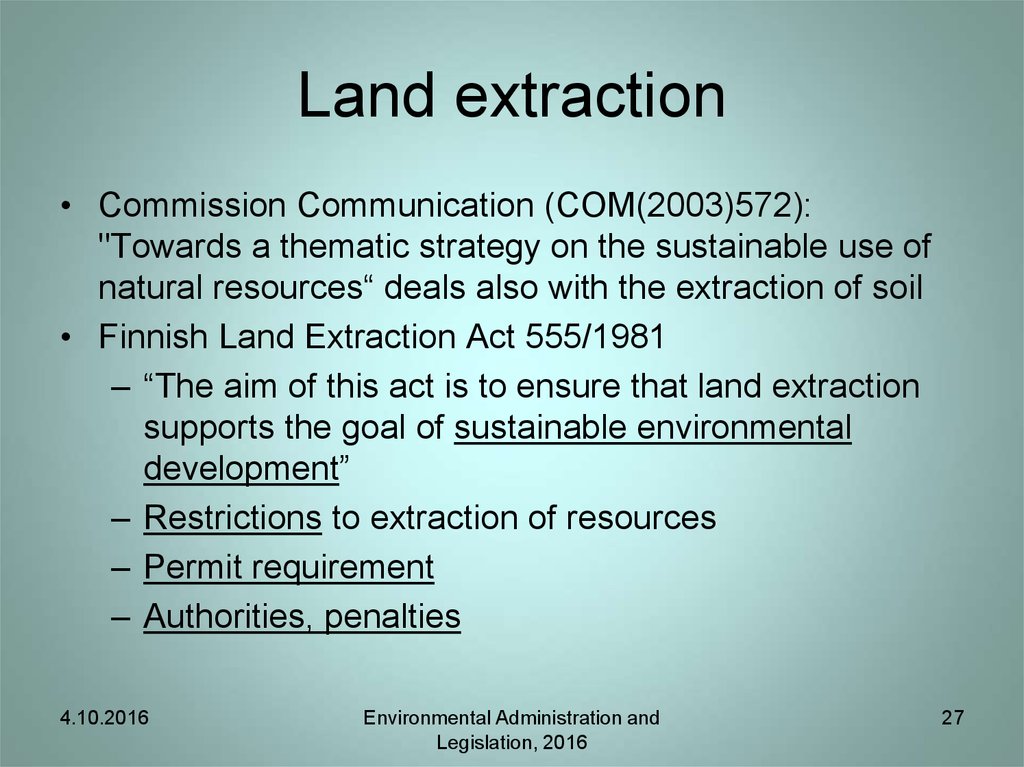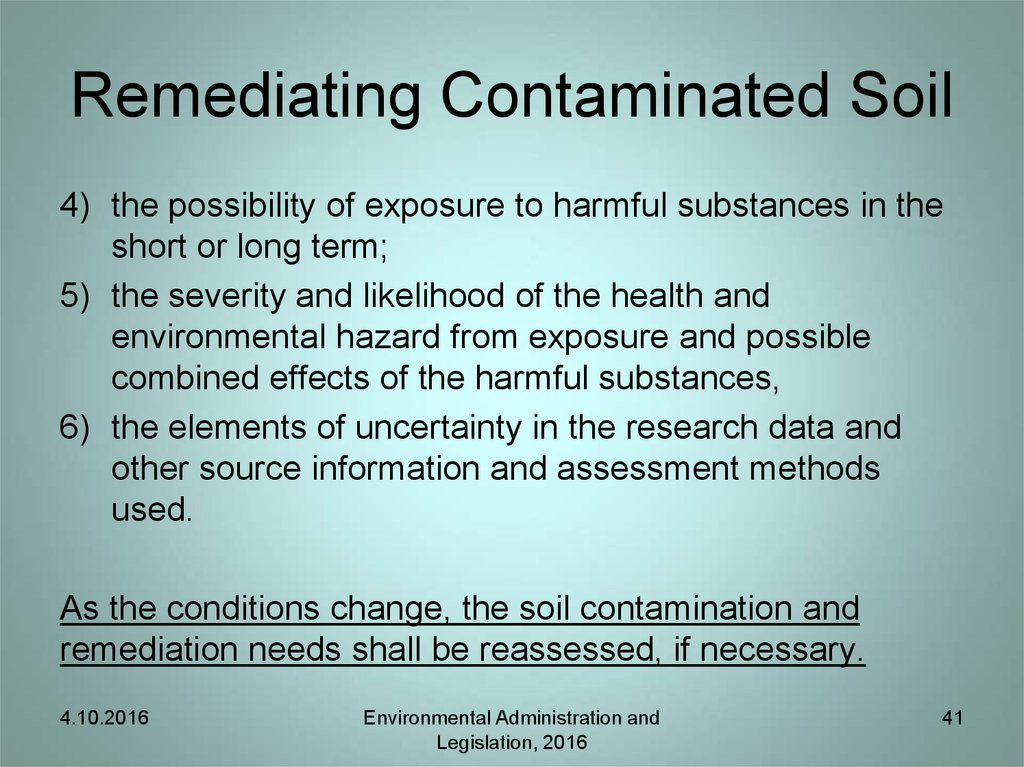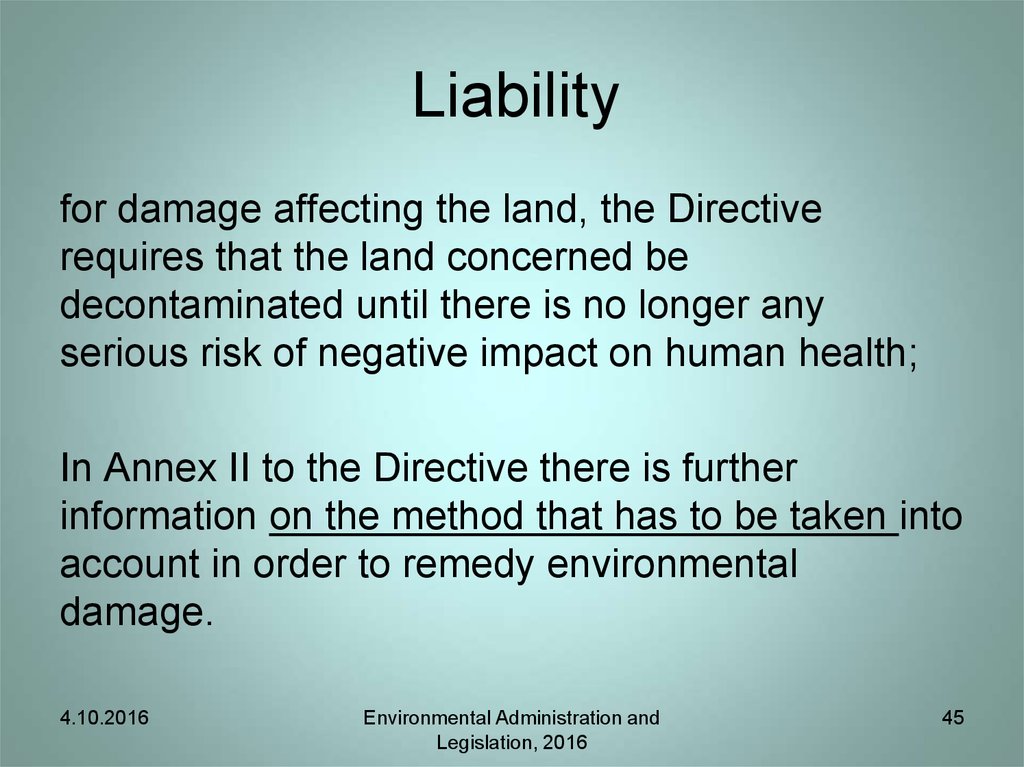Similar presentations:
Legislation on Air Pollution
1. Environmental Administration and Legislation
Mikkeli Universityof Applied Sciences
Autumn 2016
2. Dia 2
REVISIONWhat did you learn last week?
4.10.2016
Environmental Administration and
Legislation, 2016
2
3. Legislation on Air Pollution
• Air Pollution Prevention (reduction ofcertain emissions),
• Protecting the Ozone Layer,
• Climate Change Mitigation (e.g. the GHG
trading scheme),
• Noise Abatement, including permissible
sound levels e.g. for motor vehicles.
• Remember the Relevant International Agreements?
4.10.2016
Environmental Administration and
Legislation, 2016
3
4. Aspects of Climate Change Mitigation
Reduction of Greenhouse gases (how?)Carbon capture
mitigating the change itself
Flood control, land use planning…
taking steps to prepare for the effects
of climate change
4.10.2016
Environmental Administration and
Legislation, 2016
4
5. Dia 5
Land use planning4.10.2016
Environmental Administration and
Legislation, 2016
5
6. Land use planning
• EU Strategies for sustainable land use:– Urban development
– Rural development
• Land use planning as an efficient
instrument for sustainable development
and environmental protection*!
4.10.2016
Environmental Administration and
Legislation, 2016
6
7. Land use Planning: Finnish Land Use and Building Act 132/99
• “The objective is to ensure that the use of land and waterareas and building activities on them create
preconditions for a favorable living environment and
promote ecologically, economically, socially and
culturally sustainable development.”
• “The Act also aims to ensure that everyone has the right
to participate in the preparation process, and that
planning is high quality and interactive, that expertise is
comprehensive and that there is open provision of
information on matters being processed.”
4.10.2016
Environmental Administration and
Legislation, 2016
7
8. Finnish Land Use and Building Act 132/99: system of land use planning
1. “Land use in municipalities is organized and steered bylocal master plans and local detailed plans.
– The local master plan indicates the general
principles of land use in the municipality.
– The local detailed plan indicates how land-areas
within a municipality are used and built.”
2. “Regional land use plans contain a general plan for
land use for the entire region or for a specific sub-area
therein.”
4.10.2016
Environmental Administration and
Legislation, 2016
8
9. Dia 9
www.ymparisto.fi4.10.2016
Environmental Administration and
Legislation, 2016
9
10. Finnish Land Use and Building Act 132/99: Interaction and publication of planning information
1. “Plans must be prepared in interaction withsuch persons and bodies on whose
circumstances or benefits the plan may have
substantial impact, as prescribed below in this
Act”.
2. The authority preparing plans must publicize
planning information so that those concerned
are able to follow and influence the planning
process.
4.10.2016
Environmental Administration and
Legislation, 2016
10
11. Influencing land use planning
Right of appeal:– Objections may be submitted by local residents,
organizations or the authorities.
– Appeals calling for alterations to local master plans or
detailed plans approved by the municipal authorities
must be submitted to the administrative courts.
– Appeals against regional land use plans or joint local
master plans drafted by more than one municipality
should be directed to the Ministry of the Environment.
Further appeals may be taken to the Supreme
Administrative Court.
4.10.2016
Environmental Administration and
Legislation, 2016
11
12. Influencing land use
• Building permissions:– Planning permission for building developments is subject
to hearings involving the owners and tenants of
neighbouring properties.
– Authorities must ensure building developments are in
accordance with the relevant plans.
• The use of a property may not be in conflict with the
intended use, as expressed in the land use plan.
4.10.2016
Environmental Administration and
Legislation, 2016
12
13. Land Use Plan as a tool for Environmental Protection
• Land use planning is a powerful tool for at leastnoise abatement, but also for sustaining
biodiversity and enhancing environmental
health.
Examples?
• Land use plans are not only maps of which
activities are placed on what areas. They also
contain - sometimes very specific - controls on
construction projects on the area.
4.10.2016
Environmental Administration and
Legislation, 2016
13
14. Dia 14
Legislation Controlling the EnvironmentalImpacts of Mining and Soil Extraction
4.10.2016
Environmental Administration and
Legislation, 2016
14
15. Mining as an activity
Thematic Strategy on the sustainable use ofnatural resources (COM(2005) 670)
classification of natural resources:
– raw materials (e.g. minerals and biomass)
– environmental media (water, air and soil)
– flow resources (e.g. wind, geothermal and solar
energy)
– physical space required to produce or sustain the
other resources.
4.10.2016
Environmental Administration and
Legislation, 2016
15
16. Non-energy extractive industry
• Communication from the Commissionpromoting sustainable development in the
EU non-energy extractive industry
• The extractive industry is often divided into
three subsectors:
– metallic minerals (iron, copper, zinc, etc.),
– construction materials (natural stone, sand,
limestone, chalk, etc.)
– industrial minerals (salt, sulphur, etc.)
4.10.2016
Environmental Administration and
Legislation, 2016
16
17. Environmental impact of extractive operations
From the point of view of the environment, extractiveoperations raise two types of concern:
• the use of non-renewable resources
• extractive operations harm the environment
–
–
–
–
–
air, soil and water pollution,
noise,
destruction or disturbance of natural habitats,
visual impact on the surrounding landscape,
effects on groundwater levels.
4.10.2016
Environmental Administration and
Legislation, 2016
17
18. Environmental impact of extractive operations
• The waste produced by the extractive industry is a majorproblem.
– Mining waste is among the largest waste streams in the EU and
some of that waste is dangerous.
• Abandoned mine sites and unrestored quarries spoil the
landscape and can pose severe environmental threats
due especially to acid mine drainage
4.10.2016
Environmental Administration and
Legislation, 2016
18
19. The existing legislative framework for extractive industry
• The Directive on environmental impact assessmentcovers open pit mining and quarries, where the surface
of the site exceeds 25 hectares.
• The deposit of waste from the processing of minerals in
a pond is covered by Directive 99/31/EC on the landfill of
waste
• Minerals processing is covered by the Directive
concerning integrated pollution prevention and control
(IPPC), which also lays down that pollution must be
prevented or reduced through the use of best available
techniques (BAT).
• The Community eco-management and audit scheme
(EMAS) provides an instrument to integrate
environmental concerns in the extractive industry.
4.10.2016
Environmental Administration and
Legislation, 2016
19
20. The existing legislative framework for extractive industry
• Priority issues for the integration of the environment intothe extractive industry include prevention of mining
accidents, improvement of the overall environmental
performance of the industry and sound management of
mining waste.
• The White Paper on environmental liability reinforces the
key principles of polluter-pays, prevention and
precaution and others to be taken into account by the
extractive industry.
4.10.2016
Environmental Administration and
Legislation, 2016
20
21. A Case Example: Talvivaara
Talvivaara Mining Company is aninternationally significant base
metals producer with its primary
focus on nickel and zinc.
Talvivaara´s main asset is the
Talvivaara nickel mine in
Sotkamo, Finland.
(www.talvivaara.com)
4.10.2016
Environmental Administration and
Legislation, 2016
21
22. A Case Example: Talvivaara
1. Bioleaching is a process, whereby metals are leachedfrom ore as a result of bacterial action.
2. In nature, bioleaching is triggered spontaneously by
micro-organisms in the presence of air and water.
3. Commercially applied bioleaching technologies utilize
the same phenomenon, but accelerate this natural
process.
4. Several physicochemical and microbiological process
parameters are modified in order to enhance and speed
up the metal recovery process.
(www.talvivaara.com)
4.10.2016
Environmental Administration and
Legislation, 2016
22
23. A Case Example: Talvivaara
1. Talvivaara carries out its mining operations in theforested landscape of the Kainuu region, in a sparsely
populated area, which was previously in its natural
state.
2. In the areas used for mining operations, vegetation has
been removed, and the area's water bodies are used as
sources of raw water; some of the extra water
accumulated in production is led into the water bodies.
3. Preserving biodiversity and conserving the landscape in
the areas surrounding the mine is a key objective for
Talvivaara.
(www.talvivaara.com)
4.10.2016
Environmental Administration and
Legislation, 2016
23
24. A Case Example: Talvivaara
1. In accordance with the environmental permit, the impactof Talvivaara's mining operations on the area and its
wildlife is included in the scope of regular monitoring.
2. The state of the natural environment in the Talvivaara
area has been monitored since 2004.
3. The objective is to gather comprehensive data from the
mining site in order to enable mine planning in an
environmentally considerate manner and to make
comparisons during-the mining stage possible.
(www.talvivaara.com)
4.10.2016
Environmental Administration and
Legislation, 2016
24
25. Legislative tools: Talvivaara
• Planning Stage: Environmental ImpactAssessment
• Construction Stage: Environmental Permit
• Operating Stage: Permit requirements,
monitoring and planning, waste management
• Post Operating Stage: Site remediation
4.10.2016
Environmental Administration and
Legislation, 2016
25
26. Utilisation of soil
• Land extraction• Strongly linked to biodiversity, soil
protection, waste management..
• Agriculture, forestry
4.10.2016
Environmental Administration and
Legislation, 2016
26
27. Land extraction
• Commission Communication (COM(2003)572):"Towards a thematic strategy on the sustainable use of
natural resources“ deals also with the extraction of soil
• Finnish Land Extraction Act 555/1981
– “The aim of this act is to ensure that land extraction
supports the goal of sustainable environmental
development”
– Restrictions to extraction of resources
– Permit requirement
– Authorities, penalties
4.10.2016
Environmental Administration and
Legislation, 2016
27
28. Agriculture
• Commission Communication(COM(2001)162): Biodiversity Action Plan
for Agriculture
4.10.2016
Environmental Administration and
Legislation, 2016
28
29. Forestry
• Communication (COM(2006)302) on an EUForest Action Plan
• Communication (COM(2008)113) on innovative
and sustainable forest-based industries in the
EU
• Communication (COM(2005)84) - Reporting on
the implementation of the EU forestry strategy
• Communication (COM(2006)34) "An EU
Strategy for Biofuels“ -> Energy, Sustainability
4.10.2016
Environmental Administration and
Legislation, 2016
29
30. Dia 30
Soil4.10.2016
Environmental Administration and
Legislation, 2016
30
31. Legislation on Soil Pollution Concerns
• Prevention of discharge of harmfull substances• Controlling activities leading to specific risks
• Requirements for remediation of contaminated soil,
including treshold values for specific substances
4.10.2016
Environmental Administration and
Legislation, 2016
31
32. Prevention of Discharge of Harmfull Substances into Soil
• Industrial Emissions Directive!• Elimination and minimization of production, use
and release of persistent organic pollutants
• Pollution caused by nitrates from agricultural
sources (Nitrates Directive)
• REACH!
4.10.2016
Environmental Administration and
Legislation, 2016
32
33. Controlling activities leading to specific risks
• Carbon dioxide capture and geological storage• Landfill of waste
• Promoting sustainable development in the non-energy
extractive industry
• Approaches to sustainable agriculture
4.10.2016
Environmental Administration and
Legislation, 2016
33
34. Thematic strategy for soil protection
Communication COM (2002) 179 to protectsoils against erosion and pollution.
“Commission will propose legislation on a Community
information and monitoring system for soil threats.
This monitoring will provide the basis for future legislative
initiatives and will be used as a tool to adjust and review
existing policies in the field of soil protection.”
4.10.2016
Environmental Administration and
Legislation, 2016
34
35. EUROPEAN SOIL DATA CENTRE (ESDAC)
1. “The European Soil Data Centre is thethematic centre for soil related data in Europe.
2. Its ambition is to be the single reference point
for and to host all relevant soil data and
information at European level.
3. It contains a number of resources that are
organized and presented in various ways:
datasets, services/applications, maps,
documents, events, projects and external links.
“
4.10.2016
Environmental Administration and
Legislation, 2016
35
36. Remediating Contaminated Soil
COM(2006) 231; Proposal for Directive for settingout a framework for soil protection (2004) and
amending Directive 2004/35/EC:
“Member States must remediate the polluted sites in line
with a national strategy setting out the priorities. Where
it is not possible for the person responsible to sustain
the cost of remedying the site, the Member State
concerned must make provisions for the appropriate
financing.”
4.10.2016
Environmental Administration and
Legislation, 2016
36
37. Remediating Contaminated Soil
Government Decree on the Assessment ofSoil Contamination and Remediation Needs
214/2007:
“This Decree lays down the provisions for the assessment
of soil contamination and remediation needs.“
“Soil contamination and remediation needs must be
assessed if the concentration of one or several harmful
substances in the soil exceeds the threshold value
prescribed in the appendix to this Decree.”
4.10.2016
Environmental Administration and
Legislation, 2016
37
38. Dia 38
LowerNatural
Threshold guideline
Higher
Substance concentration value
value
guideline
(symbol)
mg/kg
mg/kg
mg/kg value mg/kg
Antimony
(Sb)
0,02
2
10
50
Lead (Pb)
5
60
200
750
“The guideline values for harmful substances in soil… must
be used as a tool in the assessment of soil contamination
and remediation needs.”
4.10.2016
Environmental Administration and
Legislation, 2016
38
39. Remediating Contaminated Soil
“The assessment of soil contamination and remediationneeds shall be based on an assessment of the hazard or
harm to health or the environment represented by the
harmful substances in the soil.“
How would you do this?
What aspects would you consider?
4.10.2016
Environmental Administration and
Legislation, 2016
39
40. Remediating Contaminated Soil
The following shall be taken into account in theassessment:
1) the concentration, overall amounts, properties, location
and background concentration of the hazardous
substances in the soil;
2) the soil and groundwater conditions of an area
suspected to be contaminated and factors that have an
impact on the spreading of harmful substances inside
and outside the area;
3) the current and planned purpose of use for the area
suspected to be contaminated and its environment or
groundwater;
4.10.2016
Environmental Administration and
Legislation, 2016
40
41. Remediating Contaminated Soil
4) the possibility of exposure to harmful substances in theshort or long term;
5) the severity and likelihood of the health and
environmental hazard from exposure and possible
combined effects of the harmful substances,
6) the elements of uncertainty in the research data and
other source information and assessment methods
used.
As the conditions change, the soil contamination and
remediation needs shall be reassessed, if necessary.
4.10.2016
Environmental Administration and
Legislation, 2016
41
42. Liability
Directive 2004/35/EC on environmental liability with regardto the prevention and remedying of environmental damage.
Under the terms of the Directive, environmental damage is defined as:
• direct or indirect damage to the aquatic environment covered by
Community water management legislation and by the Framework
Directive relating to marine strategy;
• direct or indirect damage to species and natural habitats protected
at Community level by the 1979 Birds Directive or by the 1992
Habitats Directive;
• direct or indirect contamination of the land which creates a
significant risk to human health.
4.10.2016
Environmental Administration and
Legislation, 2016
42
43. Liability
Where there is an imminent threat ofenvironmental damage, the competent authority
designated by each Member State may:
• require the operator (the potential polluter) to
take the necessary preventive measures; or
• take the necessary preventive measures and
then recover the costs incurred.
4.10.2016
Environmental Administration and
Legislation, 2016
43
44. Liability
Where environmental damage has occurred, thecompetent authority may:
• require the operator concerned to take the
necessary restorative measures or
• take the necessary restorative measures and
then recover the costs incurred.
• Environmental damage may be remedied in
different ways depending on the type of damage
4.10.2016
Environmental Administration and
Legislation, 2016
44
45. Liability
for damage affecting the land, the Directiverequires that the land concerned be
decontaminated until there is no longer any
serious risk of negative impact on human health;
In Annex II to the Directive there is further
information on the method that has to be taken into
account in order to remedy environmental
damage.
4.10.2016
Environmental Administration and
Legislation, 2016
45
46. Dia 46
Managing environmental impacts throughoutthe life cycle of a project:
– EIA: reducing harms during the planning and
construction phases
– IPPC licencing: reducing harms during the
planning, construction, operation and closing
phases.
4.10.2016
Environmental Administration and
Legislation, 2016
46














































 ecology
ecology law
law








